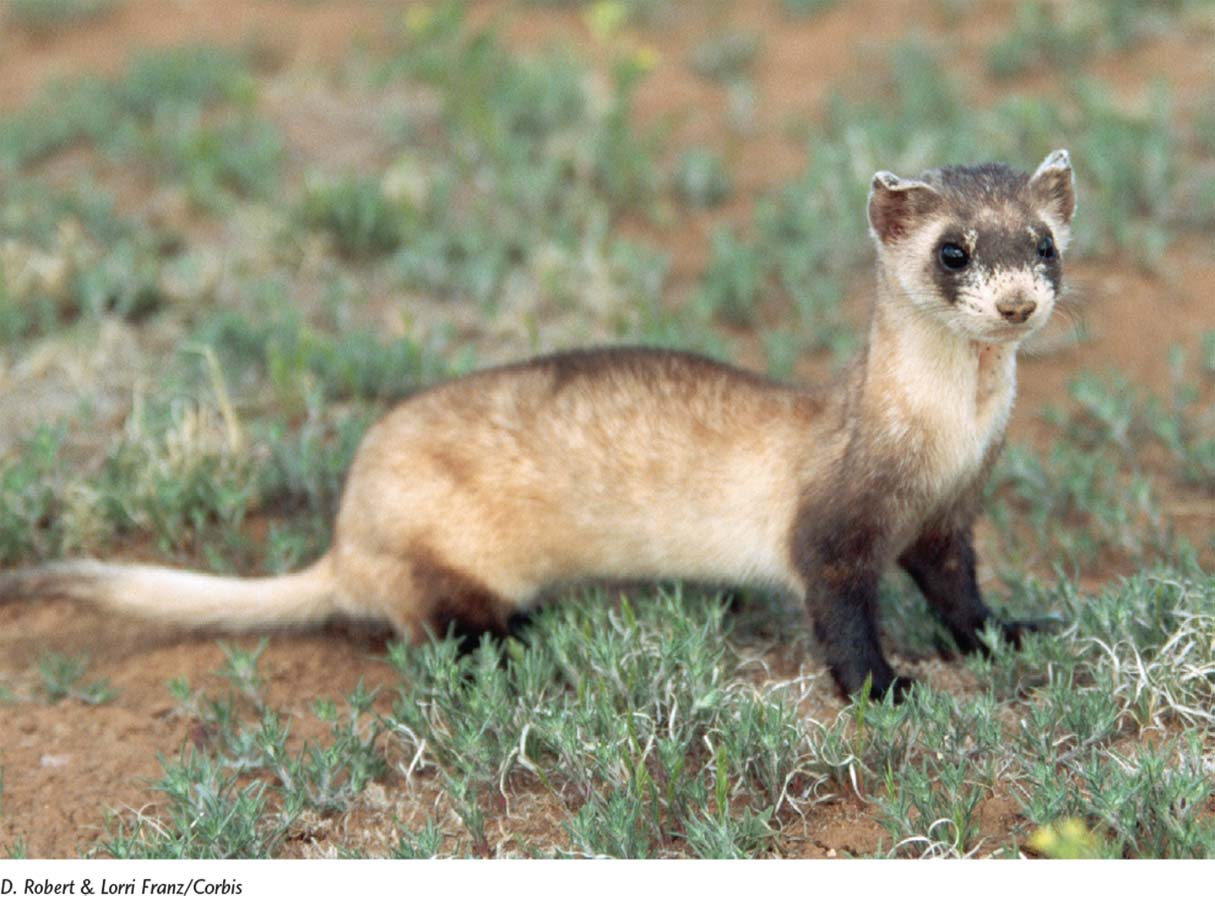Throughout the western United States, the Great Plains were once covered with large congregations of prairie dogs. Spanning several different species, these prairie dog “towns” consisted of networks of underground tunnels. They were great attractions for out-of-town tourists, but the local ranchers who had to live with the prairie dogs were not nearly as fond of the little rodents. Prairie dogs are effective herbivores that consume a great deal of plant biomass, including agricultural crops. The ranchers viewed prairie dogs as competitors for their crops and sought a variety of ways, such as poisoning, to eradicate them. An unintended consequence of the ranchers’ victory against the prairie dogs was the near-extinction of another species, the black-footed ferret (Mustela nigripes).
The black-footed ferret is a member of the weasel family and the only species of ferret native to North America. It lives in burrows and preys on prairie dogs. In fact, a single ferret can consume 125 to 150 prairie dogs in a year. Although prairie dogs had been the ferrets’ main source of food for millions of years, things started to change when settlers began plowing the Great Plains for agriculture. This destroyed many prairie dog towns, while other prairie dog towns were poisoned. Together, the plowing and poisoning have reduced the prairie dog population by 98 percent.
As we would expect in a density-dependent scenario, the reduction in the prairie dog population reduced the carrying capacity of the environment for the black-footed ferret. The poisoning campaign poisoned ferrets as well as prairie dogs. Because both small and large populations of ferrets were poisoned, and a large proportion of ferrets died in both cases, the poisoning had a density-independent effect on the ferret population.
In 1967, the black-footed ferret was officially listed as an endangered species, and the last known population died out in 1974. People feared that the black-footed ferret was extinct. In 1981, however, a small population of 130 ferrets was discovered in Wyoming. Conservation efforts began, but a highly lethal disease known as canine distemper passed through the population, reducing the entire species to a mere 18 animals.
Page 218
As part of a collaboration between federal biologists, private landowners, and several zoos, all 18 ferrets were immediately brought into captivity in the hope that a captive breeding program might be able to restore their numbers. The black-footed ferret is a K-selected species; it breeds once a year and has 3 to 4 offspring, for which the parents provide a great deal of parental care. As a result, population increases could not occur rapidly. Nevertheless, the captive population grew to 120 animals by 1989.

Black–footed ferret. Once critically endangered, populations of the black-footed ferret are rebounding as a result of collaborative conservation efforts.
(D. Robert & Lorri Franz/Corbis)
At this point, the captive breeding program was considered successful enough to allow reintroduction of the species into the wild. However, the biologists first had to consider exactly where they wanted to reintroduce the ferrets. They understood the risks of introducing all the animals into a single site because another round of disease could kill the entire population. To manage the reintroduction process, the biologists decided to make use of the metapopulation concept. They reintroduced the ferrets in several places across the Great Plains, choosing locations with healthy prairie dog populations that had a low risk of extermination.
From 1991 to 2013, black-footed ferrets were reintroduced at 19 sites, from northern Mexico all the way up to southern Canada. These efforts are clearly paying off. Today, more than 1,000 ferrets live in the wild, and hundreds more are part of the ongoing captive breeding program. But the rescue effort is not over. During years of high rainfall, outbreaks of plague, a bacterial disease carried by fleas, kill many ferrets. To combat plague, biologists have been dusting prairie dog towns with an insecticide powder that kills fleas. They are also working on a new vaccine against plague. Their goal is to achieve a wild population of 1,500 ferrets, with more than 30 animals at each of 10 reintroduction sites. If the biologists meet this goal, the ferret can be moved from the endangered species list to the less-perilous classification of “threatened.”
Critical Thinking Questions
How can humans balance the interests of ranchers who want to control prairie dog populations with the interests of conservationists who want to prevent the extinction of the black-footed ferret?
How has the metapopulation concept helped conservationists manage the recovery of the black-footed ferret?
Robbins, J. 2008. Efforts on 2 fronts to save a population of ferrets. New York Times, July 15.
 sustainability
sustainability